Weaver species
Choose different species from drop-down list and press 'Go' button. See Full species list.White-winged Widowbird Euplectes albonotatus
IUCN: Least concern Discovery: 050Categories: , nectar, pest, blue-billed widows,
News items about species
Discovery
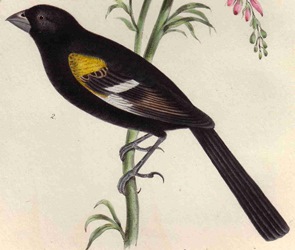
figure from Cassin 1849 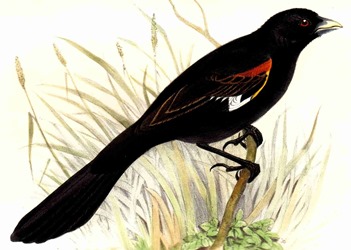
figure from Hartlaub 1863 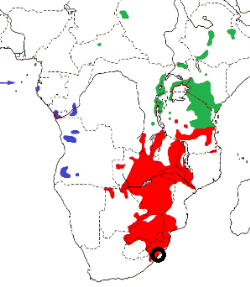
distribution, type locality circled IntroductionThe White-winged Widowbird was formally described by John Cassin, an American ornithologist.The White-winged Widowbird was collected by Jules Pierre Verreaux, a French botanist and ornithologist. Jules and his brothers were professional collectors of and traders in natural history specimens, who worked in South Africa and other parts of the world. The White-winged Widowbird specimens are labelled as Port Natal (Durban) and Cap. de B. Esp. (the Cape - Jules Verreaux worked at the South African Museum for several years, but the species would have been collected north of the Cape). Unfortunately, the Verreaux brothers did not usually keep good records on localities and dates of where specimens were collected. Although the precise collection locality is not certain, Durban is adequate as a type locality for the White-winged Widowbird. White-winged Widowbird specimens were sent to the Verreaux business in Paris where Edward Wilson [see Stone 1899 p6] obtained 3 of the widow specimens to take to the Academy of Natural Sciences of Drexel University, formerly the Academy of Natural Sciences of Philadelphia (ANSP), the oldest natural science research institution and museum in the New World. Cassin was curator of the Philadelphia Academy of Natural Sciences and he described many species of bird as they arrived at the museum. The first illustration of a White-winged Widowbird is a colour painting published by Cassin 1849. The second illustration was published by Hartlaub 1863, of the subspecies eques that was collected by John Hanning Speke. Scientific citationVidua albonotata Cassin 1848 Proc. Acad. Nat. Sci. Philad., p65 Port Natal = Durban, KwaZulu-Natal.Meaning of namesalbonotata/albonotatus - Latin albus, white; notatus, marked (notare, to mark).First English nameThe white-shouldered Widow (Reichenbach 1863).Alternate namesAngola White-winged Whydah, Cinnamon-shouldered Widowbird, East African White-winged Whydah, The white-shouldered Widow, White-fronted Widow-Bird, White-winged Whydah.CollectorJules Verreaux.Date collectedLong before 1848, but date unknown.Locality collectedPort Natal = Durban.Type specimensANSP 14224, ANSP 14225 and ANSP 14226 in Academy of Natural Sciences of Drexel University. |
The above is based on Weaver Wednesday 2, a weekly series about the discovery of each weaver species.
This species text first appeared as
Weaver Wednesday [167] - Discovery [50]: White-winged Widowbird on 2015-08-26
1. Basic biology
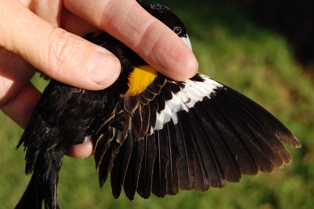

Identification. The White-winged Widowbird is a small widowbird with a fan-shaped tail. The male in breeding plumage is black with a white wing-patch and wing edgings, and white underwing; in southern African birds the epaulet (shoulder patch) is yellow (above left), while in East African birds it is cinnamon-rufous. Females (above right) and non-breeding birds may be identified in flight by the longish tail, white and yellow/rufous wing patches, and white underwing. Distribution.
The White-winged Widowbird is common in East and south-east Africa (see map below), based on Birds of Africa).
E. a. albonotatus in eastern South Africa, north-east Botswana and Namibia, to southern Tanzania (intergrading with eques around Iringa and Dodoma) (see red on map left). E. a. asymmetrurus found patchily from western Angola to western Gabon, and Sao Tome (see blue on map left). The tail of breeding males is much larger in this subspecies. E. a. eques from southern Tanzania to southern Sudan and Ethiopia with isolated populations in western Sudan and Central African Republic (see green on map left). Breeding males have cinnamon-brown (not yellow) epaulets, and females and sub-adult males have the lesser coverts edged with cinnamon. The White-winged Widowbird established a breeding population from escapees in the Sydney area in Australia, but apparently was extinct there by 1976 (read more here). This species has shown a substantial range expansion in the Free State Province of South Africa since the 1990s. Ornithologists in the Free State attribute this to increased rainfall (see maps and report here). Habitat.
The White-winged Widowbird occurs in tall bushed grassland, generally below 2000m.
Food. The White-winged Widowbird feeds on grass seeds, nectar of Aloe marlothii, and insects, including termite alates. It feeds on millet in some areas and is sometimes a minor pest. The White-winged Widowbird catches termites on the ground or hawks them in the air, returning to a perch to eat them. Breeding. This species is polygynous, with up to 4 females per male. The nest (right is oval with a large side entrance. The male builds the nest frame of dry and semi-green grass, supported by upright grass stems. The female adds a stouter weaving of finer dry grass, usually Sporobolus, inside the frame. Some nests have a small porch of projecting grassheads. Nests are usually sited below 1.5 m. Eggs may be laid before the nest is lined. Only the female incubates and feeds the nestlings, mainly by regurgitation. Nests are sometimes parasitized by the Diederik Cuckoo. Old nests may be used by Orange-breasted (Zebra) Waxbills. |
The above is based on Weaver Wednesday, a weekly series about weaver species.
This species text first appeared as
Weaver Wednesday [22]: White-winged Widowbird on 2012-11-14
2. Breeding facts
| Pair bond Polygynous, with up to four females per male Breeding season Sept-Oct in Sudan, Jun in Ethiopia; Feb-Apr in Rwanda and S DRCongo; peak Mar-Jun and recorded also Sept and Dec-Feb in Kenya; Dec-Mar in Tanzania; Apr on Sao Tome, Jan-Apr in Angola, Zambia and Malawi, Dec-Feb in Botswana, Dec-Apr in Zimbabwe, Feb-Mar in Mozambique and Oct-Apr in South Africa Nest site supported by vertical grass stems Nest building male weaves framework Colony size Male defends territory of 600-1900 m2 against conspecifics Clutch size 2-4 eggs (mean 2.6 in Zimbabwe) Egg colour pale greenish-blue, densely speckled with olive-green Egg size average size of 49 eggs 18.5 x 13.6 mm (South Africa) Incubation incubation by female only, period 12-15 days Chicks and nestling period chicks fed by female, primarily by regurgitation, nestling period 11-14 days; young independent at 36 days |
Breeding information based on Handbook of the Birds of the World, Vol. 15.
3. Photos of Weaver Nests
 Vm 19022 |  Vm 19021 |  Vm 8635 |  Vm 8520 |  Vm 1032 |
Thumb-nails of most recent PHOWN records - click on one to see its full record
See all PHOWN records for this species here.
PHOWN (Photos of Weaver Nests) provides valuable info on breeding distribution and colony sizes of weavers.
You can contribute by registering and submitting photos at Virtual Museum webpage.
4. Breeding distribution
Google map showing distribution (For species with small ranges you need to zoom in at the correct area to see the range):
yellow blob - range of weaver species; read more about this here.
![]() - PHOWN records with photos
- PHOWN records with photos
![]() - PHOWN records with no photos (Nest Record Cards, other records)
- PHOWN records with no photos (Nest Record Cards, other records)
![]() - Birdpix records
- Birdpix records
![]() - comments on out of range records, or interesting records
- comments on out of range records, or interesting records
![]() - type locality
- type locality
CLICK on the marker on the map to see individual record details.
5. Range changes
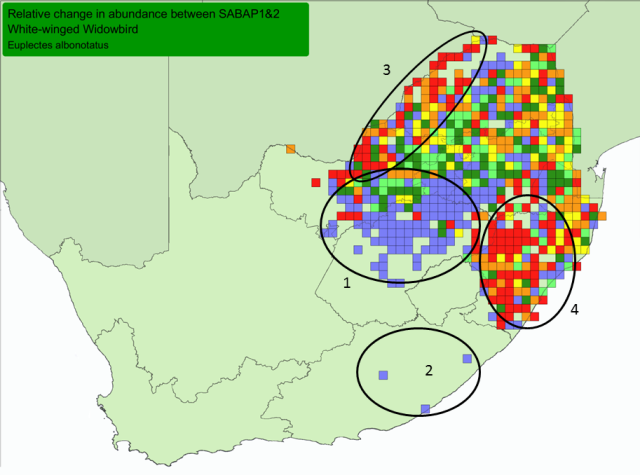
Red, orange and yellow = cells with very large, large, and small relative decreases Blue, dark green and light green = cells with very large, large and small relative increases. Cells = quarter-degree grid cells; Only cells with at least 4 checklists in both SABAP1&2 shown. All cells had this species recorded in SABAP1 or in SABAP2 or in both (more about interpretation at Biodiversity Observations 7.62: 1-13).
Range changes in SA
The points below match the points on the map above. Areas with very large increases include:
Areas with very large decreases include:
Range changes elsewhereZimbabwe: increase due to increase in rank grass around Harare (Brooke 1963a).Exotic populations established in Australia: Appendix of Dyer EE, Redding DW, Blackburn TM. 2017. The global avian invasions atlas, a database of alien bird distributions worldwide. Nature Scientific Data 4 no: 170041. | |||||||||||||||||||||||||||||||||||
The above is based on Weaver Wednesday 3, a weekly series about range changes in South African weaver species.
This species text first appeared as
Weaver Wednesday 3 [259] - Range changes [22]: White-winged Widowbird on 2017-05-31








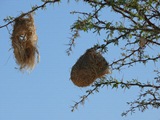


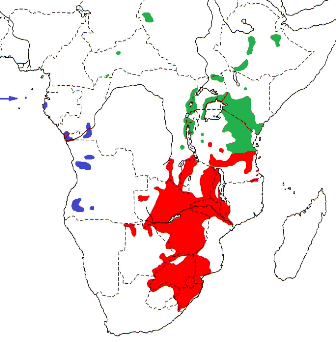 Three subspecies are currently recognised:
Three subspecies are currently recognised:
